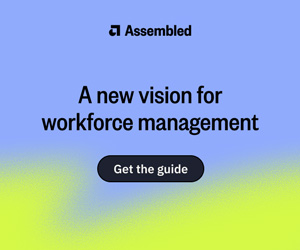Ross Daniels at Calabrio explores what’s stopping you from simplifying your contact centre approach.
‘Work-From-Anywhere’ Takes Complexity to a Whole New Level
When it comes to complexity, we tend to think about advisors and customer experience first, but what about those running the show? The rise of the work-from-anywhere/hybrid model presents a host of challenges for operational leaders.
They are faced with planning to combine in-person, virtual and at-home customer touchpoints while maintaining momentum and onboarding new recruits from a distance.
All of this with the need for heightened levels of engagement and the all-important human touch.
Maverick Managers Welcome Here
Simplicity starts with good leadership skills — yet traditional management thinking and behaviors are the biggest barriers to success.
Those leaders entrenched in a ‘we’ve always done it this way, so why fix what ain’t broke?’ way of thinking fail to realize the world has moved on—exposing them to organizational risk and diminished competitiveness.
The hybrid workforce calls for a different approach to problem-solving. Leaders can turn ‘rogue’ within a moral, ethical and financially responsible business framework.
Global analyst firm Gartner introduces ‘rogue thinking’, a management style that involves embracing 7 best practices to allow leaders to think differently.
- Feel the pain – focus on customer outcomes not process inputs.
- Steal great ideas – look for something clever from outside your industry, then embrace it and adapt it to your own.
- Break some glass – reject limits and knock down barriers.
- Gather intelligence – ask questions and never stop learning.
- Cut against the grain – rethink traditional norms. Choose to be different and use technology in new ways.
- Embrace the ridiculous – think big. There are no limits to finding a solution.
- Be a scientist – unpeel the onion till you’ve reached the essential, core truth, then start your solution journey.
5 Ways to Lead the World: Resource Planners Rule
As scheduling and forecasting take centre stage, the role of resource planners is vital to the success of their organizations. This means that resource planners, as well as their leaders, need to supplement their traditional planning expertise with a new set of skills.
- An understanding of strategic planning – today’s resource planners can help the business to understand how effective scheduling and forecasting can best serve corporate vision, company values and its brand image.
- Operational planning skills – why would you allow your business to set itself up to fail? The best planners are adept at helping the business to realize its ambitions by creating a long-term plan with forecasts, recruitment and attrition models. A plan that is truly achievable and not just pie-in-the-sky.
- Good engagement and communication skills – the modern planner is more than a spreadsheet genius – they understand the business well enough to appreciate the drivers behind demand and therefore quickly become a keen researcher and a confident communicator.
- The ability to schedule work and colleagues – it’s no longer simply about creating shifts and schedules. Effective planners envisage the wishes of the business, their colleagues and customers to develop working practices that service all of their needs. Inventive and insightful, they look for ways that time can be allocated to drive colleague engagement, enrichment and retention.
- Proactive and agile – using technology to their best advantage, successful planners are super-proactive, giving the business the agility it needs to handle fluctuating levels of supply and demand. They are the ones involved in readying the business ahead of the day with a series of short-term, ‘what-if’ forecasts and plans helping the business to prepare for the madness of ‘on-the-day’ real-time management.
Combine Skills With Technology for Maximum Impact
Match newly acquired skills with technology that is personalized, easy and smart to simplify the tricky business of running today’s complex contact centre.
Behind the scenes, the cloud makes light work of cost control or adding new agents and services quickly in a highly secure and compliant manner.
Meanwhile, the latest Workforce Engagement Management (WEM) solutions combine real-time scheduling and forecasting capabilities with powerful employee sentiment analysis to motivate and develop advisors with that all-important human touch.
This blog post has been re-published by kind permission of Calabrio – View the Original Article
For more information about Calabrio - visit the Calabrio Website
Call Centre Helper is not responsible for the content of these guest blog posts. The opinions expressed in this article are those of the author, and do not necessarily reflect those of Call Centre Helper.
Author: Calabrio
Published On: 2nd Aug 2021 - Last modified: 3rd Aug 2021
Read more about - Guest Blogs, Calabrio






 The digital foundation of a customer-centric contact centre, the Calabrio ONE workforce performance suite helps enrich and understand human interactions, empowering contact centres as a brand guardian. Calabrio ONE unites workforce optimisation (WFO), agent engagement, and business intelligence solutions into a cloud-native, fully integrated suite.
The digital foundation of a customer-centric contact centre, the Calabrio ONE workforce performance suite helps enrich and understand human interactions, empowering contact centres as a brand guardian. Calabrio ONE unites workforce optimisation (WFO), agent engagement, and business intelligence solutions into a cloud-native, fully integrated suite. 





























